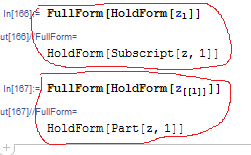Example
I came across the following simple example from A Beginner's Guide to Mathematica, by McMahon and Topa, which I believe was written circa version 5.2. (FWIW, I'm using v9.)
(* simple differential equation *)
eqn = (D[y[ x], x] == A);
(* solve the differential equation *)
result = DSolve[eqn, y[x], x];
Note to question readers: For the input below, fill in the ... with result then hit (Ctrl + minus) to get a subscript, then type in [[1,1,2]] and evaluate the function. Sorry if this is a wonkish way to present the question, but I wasn't sure of the best way to handle the front-end representation of the original input. *)
(* extract a functional dependence *)
f[x_] := ...
Evaluating:
f[x]
(* -> A*x + C[1] *)
Question
Can someone point me to documentation on this behavior or explain it? Looking at expression form (Ctrl + e) makes it clear that the front-end is interpreting the subscripted input to make this happen, but I've never seen it before.
Encountering this makes me wish developers would refactor the behavior so that one could easily apply functions other than Part in this manner.





Subscript[result, [[1, 1, 2,]]], which ought to be equivalent, I get a syntax error from the code editor (in 8.0.4). $\endgroup$